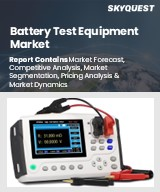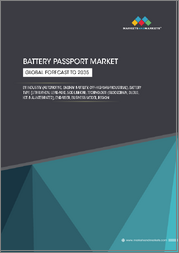
|
시장보고서
상품코드
1719195
수성 배터리 시장 : 세계 산업 규모, 점유율, 동향, 기회, 예측 - 종류별, 용도별, 지역별, 경쟁별(2020-2030년)Aqueous Battery Market - Global Industry Size, Share, Trends, Opportunity, and Forecast, Segmented By Type, By Application, By Region, By Competition, 2020-2030F |
||||||
수성 배터리 세계 시장 규모는 2024년 87억 달러, 2030년에는 127억 달러에 달할 것으로 예상되며, 예측 기간 동안 6.3%의 CAGR로 성장할 것으로 예상됩니다.
불연성이며 유해 물질을 포함하지 않는 수성 전해질을 사용하는 수성 배터리의 고유한 안전성과 환경적 이점으로 인해 시장이 성장하고 있습니다. 이러한 특성으로 인해 화재 안전이 중요한 용도에 매우 적합합니다. 또한, 태양광, 풍력 등 재생에너지의 도입이 확대됨에 따라 비용 효율적이고 확장 가능한 에너지 저장 솔루션에 대한 수요가 증가함에 따라 수성 배터리는 기존 기술을 대체할 수 있는 유력한 대안으로 떠오르고 있습니다. 아연, 철, 망간과 같이 쉽게 구할 수 있고 저렴한 재료에 의존하는 수성 배터리는 비싸고 희귀한 원소를 필요로 하는 리튬이온 배터리에 비해 시장의 매력을 더욱 높이고 있습니다. 에너지 밀도, 사이클 수명, 운영 효율성에 대한 기술적 진보가 경쟁력을 높이는 한편, 친환경 저장 시스템과 재생에너지의 통합을 지원하는 유리한 정부 정책은 상업, 산업 및 유틸리티 규모의 애플리케이션에서 더 많은 채택을 촉진하고 있습니다.
| 시장 개요 | |
|---|---|
| 예측 기간 | 2026-2030년 |
| 시장 규모 : 2024년 | 87억 달러 |
| 시장 규모 : 2030년 | 127억 달러 |
| CAGR : 2025-2030년 | 6.3% |
| 급성장 부문 | 납축배터리 |
| 최대 시장 | 북미 |
시장 촉진요인
안전하고 지속가능한 에너지 저장 솔루션에 대한 수요 증가
주요 시장 과제
리튬이온 배터리에 비해 낮은 에너지 밀도
주요 시장 동향
그리드 에너지 저장 및 재생에너지 통합에 대한 채택 증가
목차
제1장 개요
제2장 조사 방법
제3장 주요 요약
제4장 고객의 소리
제5장 세계의 수성 배터리 시장 전망
- 시장 규모 및 예측
- 금액별
- 시장 점유율과 예측
- 종류별(납축배터리, 망간 배터리, 알칼리 배터리, 플로우 배터리, 기타)
- 용도별(자동차, 가전제품, 전력·유틸리티, 산업, 상업, 기타)
- 지역별(북미, 유럽, 남미, 중동 및 아프리카, 아시아태평양)
- 기업별(2024)
- 시장 맵
제6장 북미의 수성 배터리 시장 전망
- 시장 규모 및 예측
- 시장 점유율과 예측
- 북미 : 국가별 분석
- 미국
- 캐나다
- 멕시코
제7장 유럽의 수성 배터리 시장 전망
- 시장 규모 및 예측
- 시장 점유율과 예측
- 유럽 : 국가별 분석
- 독일
- 프랑스
- 영국
- 이탈리아
- 스페인
제8장 아시아태평양의 수성 배터리 시장 전망
- 시장 규모 및 예측
- 시장 점유율과 예측
- 아시아태평양 : 국가별 분석
- 중국
- 인도
- 일본
- 한국
- 호주
제9장 중동 및 아프리카의 수성 배터리 시장 전망
- 시장 규모 및 예측
- 시장 점유율과 예측
- 중동 및 아프리카 : 국가별 분석
- 사우디아라비아
- 아랍에미리트
- 남아프리카공화국
제10장 남미의 수성 배터리 시장 전망
- 시장 규모 및 예측
- 시장 점유율과 예측
- 남미 : 국가별 분석
- 브라질
- 콜롬비아
- 아르헨티나
제11장 시장 역학
- 성장 촉진요인
- 과제
제12장 시장 동향과 발전
- 인수합병
- 제품 출시
- 최근 동향
제13장 기업 개요
- Enerpoly AB
- Salient Energy Technologies, Inc
- LG Chem, Ltd.
- Contemporary Amperex Technology Co., Limited(CATL)
- Amperex Technology Limited
- Panasonic Corporation
- Samsung SDI Co., Ltd.
- Murata Manufacturing Co., Ltd
- BYD Lithium Battery Co., Ltd.
- Toshiba Corporation
제14장 전략적 제안
제15장 조사 회사 소개 및 면책사항
ksm 25.05.23The Global Aqueous Battery Market was valued at USD 8.7 billion in 2024 and is projected to reach USD 12.7 billion by 2030, growing at a CAGR of 6.3% during the forecast period. The market is gaining momentum due to the inherent safety and environmental advantages of aqueous batteries, which use water-based electrolytes that are non-flammable and free from hazardous substances. These characteristics make them highly suitable for applications where fire safety is critical. Additionally, the growing deployment of renewable energy sources like solar and wind is increasing the demand for cost-effective and scalable energy storage solutions, positioning aqueous batteries as a viable alternative to traditional technologies. Their reliance on readily available and affordable materials such as zinc, iron, and manganese further enhances their market appeal compared to lithium-ion batteries, which require costly and scarce elements. Technological progress in energy density, cycle life, and operational efficiency is boosting competitiveness, while favorable government policies supporting eco-friendly storage systems and renewable integration are driving further adoption across commercial, industrial, and utility-scale applications.
| Market Overview | |
|---|---|
| Forecast Period | 2026-2030 |
| Market Size 2024 | USD 8.7 Billion |
| Market Size 2030 | USD 12.7 Billion |
| CAGR 2025-2030 | 6.3% |
| Fastest Growing Segment | Lead-Acid Batteries |
| Largest Market | North America |
Key Market Drivers
Rising Demand for Safe and Sustainable Energy Storage Solutions
The shift toward safer and more sustainable energy storage systems is a major factor fueling the growth of the aqueous battery market. Unlike lithium-ion and lead-acid batteries that use flammable and toxic materials, aqueous batteries operate using water-based electrolytes, minimizing the risk of fire, explosion, and thermal runaway. This makes them particularly attractive for large-scale storage in commercial buildings, industrial facilities, and utility-grade grid systems. Their superior safety profile is expanding their use across markets where operational security is paramount. In addition, aqueous batteries offer significant environmental benefits. They are typically made with abundant and eco-friendly materials such as zinc, manganese, and iron, and they do not emit harmful byproducts or require complex disposal processes. As environmental regulations tighten and sustainability initiatives grow globally, these characteristics are accelerating the adoption of aqueous batteries. The trend is especially visible in regions with high renewable energy penetration, where safe and green energy storage is essential for balancing grid loads and ensuring consistent power supply.
Key Market Challenges
Lower Energy Density Compared to Lithium-Ion Batteries
Despite their advantages, aqueous batteries face limitations in terms of energy density, which remains significantly lower than that of lithium-ion alternatives. Energy density, a measure of how much energy can be stored per unit weight, is critical for applications such as electric vehicles, aerospace, and portable electronics. While lithium-ion batteries typically achieve energy densities between 150 and 250 Wh/kg, aqueous batteries generally fall in the range of 30 to 100 Wh/kg. This disparity limits their suitability in weight-sensitive applications, where high power-to-weight ratios are essential. The reduced voltage window of water-based electrolytes, a core component of aqueous battery chemistry, is a primary reason for this limitation. As a result, sectors demanding compact and lightweight storage systems continue to favor lithium-ion technology, despite its safety risks and higher environmental costs. While research efforts are underway to improve the energy density of aqueous batteries, current technological constraints remain a barrier to broader market penetration in specific high-performance segments.
Key Market Trends
Growing Adoption in Grid Energy Storage and Renewable Integration
An important trend shaping the aqueous battery market is the increasing use of these systems in grid storage and renewable energy integration. As solar and wind energy adoption rises, so does the need for reliable energy storage to address intermittency issues and maintain grid stability. Aqueous batteries offer a compelling solution due to their safety, durability, and cost advantages. Their use of non-flammable, water-based electrolytes allows for safer deployment in large-scale settings without the risk of thermal events. Additionally, these batteries support long cycle life and low maintenance requirements, making them suitable for long-duration storage applications. Countries worldwide are investing in renewable energy initiatives paired with battery storage systems, and aqueous technologies are gaining recognition as a scalable and environmentally responsible option. The trend is particularly evident in emerging markets and rural electrification programs, where energy access and safety are top priorities. With governments promoting green infrastructure and utilities seeking dependable backup solutions, aqueous batteries are set to play a growing role in next-generation energy systems.
Key Market Players
- Enerpoly AB
- Salient Energy Technologies, Inc.
- LG Chem, Ltd.
- Contemporary Amperex Technology Co., Limited (CATL)
- Amperex Technology Limited (ATL)
- Panasonic Corporation
- Samsung SDI Co., Ltd.
- Murata Manufacturing Co., Ltd.
- BYD Lithium Battery Co., Ltd.
- Toshiba Corporation
Report Scope:
In this report, the Global Aqueous Battery Market has been segmented into the following categories, in addition to the industry trends which have also been detailed below:
Aqueous Battery Market, By Type:
- Lead-Acid Batteries
- Zinc-Carbon Batteries
- Alkaline
- Flow Batteries
- Others
Aqueous Battery Market, By Application:
- Automotive
- Consumer Electronics
- Power & Utility
- Industrial
- Commercial
- Others
Aqueous Battery Market, By Region:
- North America
- United States
- Canada
- Mexico
- Europe
- Germany
- France
- United Kingdom
- Italy
- Spain
- Asia Pacific
- China
- India
- Japan
- South Korea
- Australia
- South America
- Brazil
- Colombia
- Argentina
- Middle East & Africa
- Saudi Arabia
- UAE
- South Africa
Competitive Landscape
Company Profiles: Detailed analysis of the major companies present in the Global Aqueous Battery Market.
Available Customizations:
Global Aqueous Battery Market report with the given market data, TechSci Research offers customizations according to a company's specific needs. The following customization options are available for the report:
Company Information
- Detailed analysis and profiling of additional market players (up to five).
Table of Contents
1. Product Overview
- 1.1. Market Definition
- 1.2. Scope of the Market
- 1.2.1. Markets Covered
- 1.2.2. Years Considered for Study
- 1.2.3. Key Market Segmentations
2. Research Methodology
- 2.1. Objective of the Study
- 2.2. Baseline Methodology
- 2.3. Key Industry Partners
- 2.4. Major Association and Secondary Sources
- 2.5. Forecasting Methodology
- 2.6. Data Triangulation & Validation
- 2.7. Assumptions and Limitations
3. Executive Summary
- 3.1. Overview of the Market
- 3.2. Overview of Key Market Segmentations
- 3.3. Overview of Key Market Players
- 3.4. Overview of Key Regions/Countries
- 3.5. Overview of Market Drivers, Challenges, and Trends
4. Voice of Customer
5. Global Aqueous Battery Market Outlook
- 5.1. Market Size & Forecast
- 5.1.1. By Value
- 5.2. Market Share & Forecast
- 5.2.1. By Type (Lead-Acid Batteries, Zinc-Carbon Batteries, Alkaline, Flow Batteries, Others)
- 5.2.2. By Application (Automotive, Consumer Electronics, Power & Utility, Industrial, Commercial, Others)
- 5.2.3. By Region (North America, Europe, South America, Middle East & Africa, Asia Pacific)
- 5.3. By Company (2024)
- 5.4. Market Map
6. North America Aqueous Battery Market Outlook
- 6.1. Market Size & Forecast
- 6.1.1. By Value
- 6.2. Market Share & Forecast
- 6.2.1. By Type
- 6.2.2. By Application
- 6.2.3. By Country
- 6.3. North America: Country Analysis
- 6.3.1. United States Aqueous Battery Market Outlook
- 6.3.1.1. Market Size & Forecast
- 6.3.1.1.1. By Value
- 6.3.1.2. Market Share & Forecast
- 6.3.1.2.1. By Type
- 6.3.1.2.2. By Application
- 6.3.1.1. Market Size & Forecast
- 6.3.2. Canada Aqueous Battery Market Outlook
- 6.3.2.1. Market Size & Forecast
- 6.3.2.1.1. By Value
- 6.3.2.2. Market Share & Forecast
- 6.3.2.2.1. By Type
- 6.3.2.2.2. By Application
- 6.3.2.1. Market Size & Forecast
- 6.3.3. Mexico Aqueous Battery Market Outlook
- 6.3.3.1. Market Size & Forecast
- 6.3.3.1.1. By Value
- 6.3.3.2. Market Share & Forecast
- 6.3.3.2.1. By Type
- 6.3.3.2.2. By Application
- 6.3.3.1. Market Size & Forecast
- 6.3.1. United States Aqueous Battery Market Outlook
7. Europe Aqueous Battery Market Outlook
- 7.1. Market Size & Forecast
- 7.1.1. By Value
- 7.2. Market Share & Forecast
- 7.2.1. By Type
- 7.2.2. By Application
- 7.2.3. By Country
- 7.3. Europe: Country Analysis
- 7.3.1. Germany Aqueous Battery Market Outlook
- 7.3.1.1. Market Size & Forecast
- 7.3.1.1.1. By Value
- 7.3.1.2. Market Share & Forecast
- 7.3.1.2.1. By Type
- 7.3.1.2.2. By Application
- 7.3.1.1. Market Size & Forecast
- 7.3.2. France Aqueous Battery Market Outlook
- 7.3.2.1. Market Size & Forecast
- 7.3.2.1.1. By Value
- 7.3.2.2. Market Share & Forecast
- 7.3.2.2.1. By Type
- 7.3.2.2.2. By Application
- 7.3.2.1. Market Size & Forecast
- 7.3.3. United Kingdom Aqueous Battery Market Outlook
- 7.3.3.1. Market Size & Forecast
- 7.3.3.1.1. By Value
- 7.3.3.2. Market Share & Forecast
- 7.3.3.2.1. By Type
- 7.3.3.2.2. By Application
- 7.3.3.1. Market Size & Forecast
- 7.3.4. Italy Aqueous Battery Market Outlook
- 7.3.4.1. Market Size & Forecast
- 7.3.4.1.1. By Value
- 7.3.4.2. Market Share & Forecast
- 7.3.4.2.1. By Type
- 7.3.4.2.2. By Application
- 7.3.4.1. Market Size & Forecast
- 7.3.5. Spain Aqueous Battery Market Outlook
- 7.3.5.1. Market Size & Forecast
- 7.3.5.1.1. By Value
- 7.3.5.2. Market Share & Forecast
- 7.3.5.2.1. By Type
- 7.3.5.2.2. By Application
- 7.3.5.1. Market Size & Forecast
- 7.3.1. Germany Aqueous Battery Market Outlook
8. Asia Pacific Aqueous Battery Market Outlook
- 8.1. Market Size & Forecast
- 8.1.1. By Value
- 8.2. Market Share & Forecast
- 8.2.1. By Type
- 8.2.2. By Application
- 8.2.3. By Country
- 8.3. Asia Pacific: Country Analysis
- 8.3.1. China Aqueous Battery Market Outlook
- 8.3.1.1. Market Size & Forecast
- 8.3.1.1.1. By Value
- 8.3.1.2. Market Share & Forecast
- 8.3.1.2.1. By Type
- 8.3.1.2.2. By Application
- 8.3.1.1. Market Size & Forecast
- 8.3.2. India Aqueous Battery Market Outlook
- 8.3.2.1. Market Size & Forecast
- 8.3.2.1.1. By Value
- 8.3.2.2. Market Share & Forecast
- 8.3.2.2.1. By Type
- 8.3.2.2.2. By Application
- 8.3.2.1. Market Size & Forecast
- 8.3.3. Japan Aqueous Battery Market Outlook
- 8.3.3.1. Market Size & Forecast
- 8.3.3.1.1. By Value
- 8.3.3.2. Market Share & Forecast
- 8.3.3.2.1. By Type
- 8.3.3.2.2. By Application
- 8.3.3.1. Market Size & Forecast
- 8.3.4. South Korea Aqueous Battery Market Outlook
- 8.3.4.1. Market Size & Forecast
- 8.3.4.1.1. By Value
- 8.3.4.2. Market Share & Forecast
- 8.3.4.2.1. By Type
- 8.3.4.2.2. By Application
- 8.3.4.1. Market Size & Forecast
- 8.3.5. Australia Aqueous Battery Market Outlook
- 8.3.5.1. Market Size & Forecast
- 8.3.5.1.1. By Value
- 8.3.5.2. Market Share & Forecast
- 8.3.5.2.1. By Type
- 8.3.5.2.2. By Application
- 8.3.5.1. Market Size & Forecast
- 8.3.1. China Aqueous Battery Market Outlook
9. Middle East & Africa Aqueous Battery Market Outlook
- 9.1. Market Size & Forecast
- 9.1.1. By Value
- 9.2. Market Share & Forecast
- 9.2.1. By Type
- 9.2.2. By Application
- 9.2.3. By Country
- 9.3. Middle East & Africa: Country Analysis
- 9.3.1. Saudi Arabia Aqueous Battery Market Outlook
- 9.3.1.1. Market Size & Forecast
- 9.3.1.1.1. By Value
- 9.3.1.2. Market Share & Forecast
- 9.3.1.2.1. By Type
- 9.3.1.2.2. By Application
- 9.3.1.1. Market Size & Forecast
- 9.3.2. UAE Aqueous Battery Market Outlook
- 9.3.2.1. Market Size & Forecast
- 9.3.2.1.1. By Value
- 9.3.2.2. Market Share & Forecast
- 9.3.2.2.1. By Type
- 9.3.2.2.2. By Application
- 9.3.2.1. Market Size & Forecast
- 9.3.3. South Africa Aqueous Battery Market Outlook
- 9.3.3.1. Market Size & Forecast
- 9.3.3.1.1. By Value
- 9.3.3.2. Market Share & Forecast
- 9.3.3.2.1. By Type
- 9.3.3.2.2. By Application
- 9.3.3.1. Market Size & Forecast
- 9.3.1. Saudi Arabia Aqueous Battery Market Outlook
10. South America Aqueous Battery Market Outlook
- 10.1. Market Size & Forecast
- 10.1.1. By Value
- 10.2. Market Share & Forecast
- 10.2.1. By Type
- 10.2.2. By Application
- 10.2.3. By Country
- 10.3. South America: Country Analysis
- 10.3.1. Brazil Aqueous Battery Market Outlook
- 10.3.1.1. Market Size & Forecast
- 10.3.1.1.1. By Value
- 10.3.1.2. Market Share & Forecast
- 10.3.1.2.1. By Type
- 10.3.1.2.2. By Application
- 10.3.1.1. Market Size & Forecast
- 10.3.2. Colombia Aqueous Battery Market Outlook
- 10.3.2.1. Market Size & Forecast
- 10.3.2.1.1. By Value
- 10.3.2.2. Market Share & Forecast
- 10.3.2.2.1. By Type
- 10.3.2.2.2. By Application
- 10.3.2.1. Market Size & Forecast
- 10.3.3. Argentina Aqueous Battery Market Outlook
- 10.3.3.1. Market Size & Forecast
- 10.3.3.1.1. By Value
- 10.3.3.2. Market Share & Forecast
- 10.3.3.2.1. By Type
- 10.3.3.2.2. By Application
- 10.3.3.1. Market Size & Forecast
- 10.3.1. Brazil Aqueous Battery Market Outlook
11. Market Dynamics
- 11.1. Drivers
- 11.2. Challenges
12. Market Trends and Developments
- 12.1. Merger & Acquisition (If Any)
- 12.2. Product Launches (If Any)
- 12.3. Recent Developments
13. Company Profiles
- 13.1. Enerpoly AB
- 13.1.1. Business Overview
- 13.1.2. Key Revenue and Financials
- 13.1.3. Recent Developments
- 13.1.4. Key Personnel
- 13.1.5. Key Product/Services Offered
- 13.2. Salient Energy Technologies, Inc
- 13.3. LG Chem, Ltd.
- 13.4. Contemporary Amperex Technology Co., Limited (CATL)
- 13.5. Amperex Technology Limited
- 13.6. Panasonic Corporation
- 13.7. Samsung SDI Co., Ltd.
- 13.8. Murata Manufacturing Co., Ltd
- 13.9. BYD Lithium Battery Co., Ltd.
- 13.10. Toshiba Corporation
14. Strategic Recommendations
15. About Us & Disclaimer
(주말 및 공휴일 제외)


















